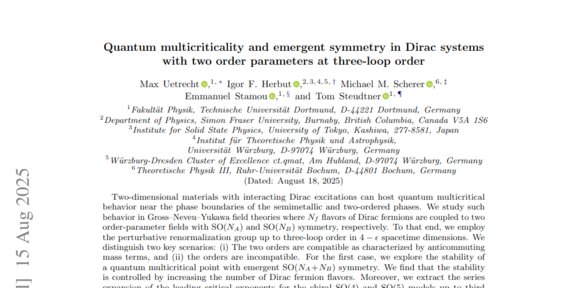Quantum multicriticality and emergent symmetry in Dirac systems with two order parameters at three-loop order
- Stamou
- Hiller

Abstract:
Two-dimensional materials with interacting Dirac excitations can host quantum multicritical behavior near the phase boundaries of the semimetallic and two-ordered phases. We study such behavior in Gross-Neveu-Yukawa field theories where Nf flavors of Dirac fermions are coupled to two order-parameter fields with SO(NA) and SO(NB) symmetry, respectively. To that end, we employ the perturbative renormalization group up to three-loop order in 4-ε spacetime dimensions. We distinguish two key scenarios: (i) The two orders are compatible as characterized by anticommuting mass terms, and (ii) the orders are incompatible. For the first case, we explore the stability of a quantum multicritical point with emergent SO(NA+NB) symmetry. We find that the stability is controlled by increasing the number of Dirac fermion flavors. Moreover, we extract the series expansion of the leading critical exponents for the chiral SO(4) and SO(5) models up to third order in ε. Notably, we find a tendency towards rapidly growing expansion coefficients at higher orders, rendering an extrapolation to ε=1 difficult. For the second scenario, we study a model with SO(4)≃SO(3)×SO(3) symmetry, which was recently suggested to describe criticality of antiferromagnetism and superconductivity in Dirac systems. However, it was also argued that a physically admissible renormalization-group fixed point exists only for Nf above a critical number Nc>. We determine the corresponding series expansion at three-loop order as Nc>≈16.83-7.14ε-7.12ε2. This suggests that the physical choice of Nf=2 may be a borderline case, where true criticality and pseudocriticality, as induced by fixed-point annihilation, are extremely challenging to distinguish.
Link to the paper:

